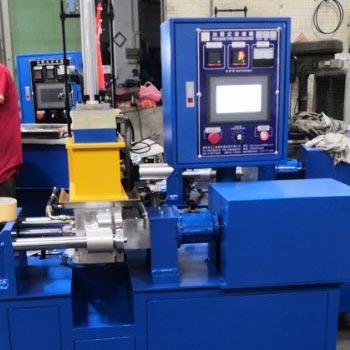In today’s competitive high-performance material research,product development, and quality control — from polymers to adhesives, ceramics, and specialty chemicals — the demand for precise and efficient mixing equipment has increased significantly.
Before a new material reaches mass production, it undergoes strict research, formulation, and testing in laboratories.
Among the most widely used laboratory mixing machines are the lab kneader and the two roll mixing mill equipment.
Although both lab equipment serve the same purpose of mixing and compounding materials, they are designed for different material characteristics and processing requirements. Below, let us explore their common applications across various industries.
1. Lab Kneader — Common Applications
Lab kneader , also known as sigma kneader , which feature a small-capacity versions specially for laboratories . adopt , . The Lab kneader for material development is specifically designed for handle with high-viscosity, semi-solid, and paste-like materials with precision and consistency.
This high viscosity kneader mixer adopt dual specialized blades, such as the sigma or Z-blade , rotating inside an enclosed chamber to perform intense shearing, mixing, and kneading action on complex compound materials. Therefore , with the help of lab sigma kneader mixer, it ensure researchers and engineers can scale up formulations with confidence.
2. Laboratory Mixing Mill Equipment — Common Applications
In the field of polymer engineering,thermoplastics, plastics, rubber, and advanced material research, consistent formulation and precise processing are crucial for innovation.
When researchers develop new materials, they need lab mixing equipment to test the formulation and simulate industrial production via these small scale mixing equipment for laboratory .
Laboratory mixing mill equipment, which are also commonly known as lab two-roll mills, they are specially designed for plasticizing, sheeting, and mixing various materials— from polymers and elastomers to specialty blends — including rubber, plastic ,polymer ,PVC , silicone , thermoplastics, and elastomers etc.
Different from lab kneaders, laboratory two roll mixing mill equipment are mainly used for solid-to-solid mixing and thermal processing.
3. Suitable Materials & Industries of Lab Kneader & Mixing Mill
* Lab Kneader: Adhesives, ceramics, batteries, specialty chemicals, high-viscosity pastes
* Mixing Mill: Rubber, plastics, thermoplastics, pigments, polymers
4. Key Advantages of Lab Kneader & Mixing Mill
* Lab Kneader: Precise mixing, vacuum integration, ideal for R&D
* Mixing Mill: Perfect for material sheet formation, solid polymer testing, pigment dispersion
5. Comparison Between Lab Kneader and Mixing Mill
| Feature | Lab Kneader | Laboratory Mixing Mill |
| Material Type | High-viscosity pastes & semi-solids | Solid polymers, rubbers & thermoplastics |
| Mixing Mechanism | Sigma blades (shear + compression) | Two-roll sheeting & blending |
| Best For | Adhesives, polymers, ceramics, batteries | Rubber compounds, plastics, color masterbatch |
| Processing Scale | R&D, small-batch production | Testing, sheet formation, QC |
| Vacuum/Heating | Often equipped with heating & vacuum | Typically equipped with heating rolls |
| Applications | Lab Kneader | Laboratory Mixing Mill |
| Polymer Compounding | ✔ High-viscosity mixing | ✔ Solid thermoplastic blending |
| Adhesives & Sealants | ✔ Epoxy, silicone, PU | ✖ Limited use |
| Ceramics & Batteries | ✔ Slurry & electrode preparation | ✖ Not used |
| Rubber Compounding | ✖ Limited | ✔ Ideal for sheet forming |
| Color Master batch | ✔ Liquid dispersions | ✔ Solid pigment dispersion |
| Food & Pharma | ✔ Chocolate, ointments, dough | ✔ Sheet-based QC testing |
Industries Process from Both Lab Kneader and Mixing Mill
In many industries ,both laboratory sigma kneader mixer and small-scale two roll mill need to work together to process and homogenize ingredients, particularly for high-viscosity or elastic materials. Two roll open mixing mills provide gentle, basic mixing, while lab kneaders perform intensive, high-shear mixing and kneading action.
* Polymer & Plastics Industry → Testing new formulations, color master batch development
* Rubber & Elastomers → Compounding, durability testing
* Battery & Ceramics → Slurry preparation and electrode material blending
* Pharmaceuticals & Cosmetics → Ointments, gels, and creams
* Food Industry → Gums and starches , chocolate, dough, bread, bagels, pizza and high-viscosity flavorings
In conclusion , In material development, both lab kneader and lab two roll mill equipment is not just a piece of equipment,they are one bridge between innovation and production. and In many times ,both these two mixing equipment need to be used together to handle material.
By offering homogeneous mixing, versatility, and precise control, they allow researchers to test and develop new materials with confidence, knowing that their formulations from small-scale laboratories ,to scale up industrial production successfully .
You are welcome to visit why laboratories mixing mill equipment is essential for more about Polymer two roll mixing machine.
Whether you are looking for high viscosity kneader for polymers or laboratory open mixing mill equipment , they can be tailored as per your application at Simptek .







